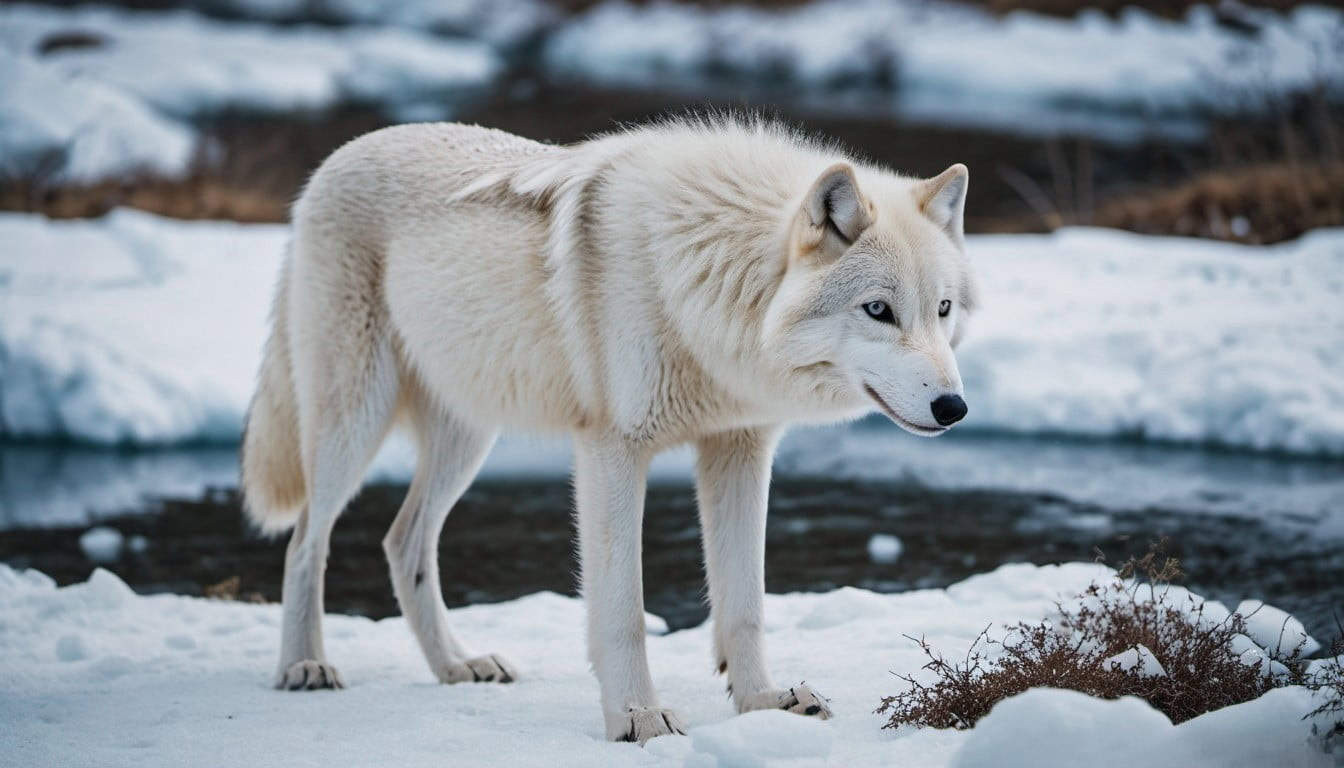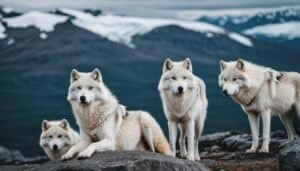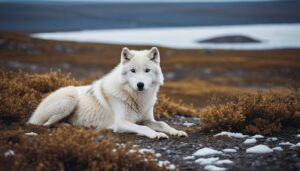Introduction
In the harsh and frozen habitats of the Arctic, finding water is a crucial aspect of survival for Arctic wolves. These resilient creatures have adapted various strategies to locate and utilize water sources despite the extreme conditions
This article will delve into the primary water sources for Arctic wolves, the impact of seasonal changes, their physical and behavioral adaptations, and the challenges and threats they face in securing water
Primary Water Sources for Arctic Wolves
In the frozen Arctic tundra, where temperatures often plunge below freezing and liquid water is scarce, Arctic wolves have developed ingenious ways to meet their hydration needs. This section explores the primary water sources that Arctic wolves rely on to survive in such a harsh environment
Snow as a Hydration Source
Snow is the most abundant form of water available to Arctic wolves. While it might seem counterintuitive to us, Arctic wolves consume snow to stay hydrated. Eating snow allows them to ingest water in solid form, which their bodies can then process
However, this method comes with energy costs. Melting snow internally requires metabolic energy, which is a precious resource in such a cold environment. Studies have shown that Arctic wolves will often eat snow during hunts or when they are resting, balancing their need for hydration with their need to conserve energy (Mech, 1970)
Ice Melting Techniques
In addition to consuming snow, Arctic wolves can also access water by melting ice
When temperatures rise slightly or during the brief Arctic summer, ice can begin to melt, providing pools of water. Wolves have been observed using their body heat to melt small patches of ice
For instance, by lying on a specific spot, they can create a small depression in the ice that melts over time, providing a small but critical source of water. This technique is especially useful during late spring and early summer when ice starts to break apart
Accessing Water Under Ice
Another critical method Arctic wolves use to find water is by accessing sources beneath the ice. They often seek out areas where the ice is thinner, such as near rivers or streams. Using their keen sense of smell, they can detect the presence of water under the ice
Arctic wolves will then dig through the snow and ice to reach these water sources. This behavior has been observed particularly during winter months when surface water is completely frozen. By locating and accessing these hidden water reserves, Arctic wolves can hydrate without expending excessive energy on melting snow
These primary water sources—snow, ice, and water under ice—are vital for the survival of Arctic wolves. Their ability to locate and utilize these resources is a testament to their adaptation to one of the planet’s most extreme environments
The strategies they employ ensure they can maintain hydration and survive the harsh conditions of the Arctic tundra
Seasonal Changes and Water Availability
Seasonal changes play a significant role in the availability of water sources for Arctic wolves. The extreme variations in temperature and weather conditions throughout the year impact how and where these wolves can find water
This section examines the challenges and opportunities presented by each season
Winter and Limited Water Access
During the long Arctic winter, temperatures can plummet to -40 degrees Fahrenheit or lower, freezing nearly all surface water. In these conditions, Arctic wolves face significant challenges in finding water
With streams, lakes, and rivers frozen solid, they rely heavily on consuming snow and ice for hydration. The energy required to melt snow and ice internally can be considerable, making it essential for wolves to balance their hydration needs with their energy expenditure
Arctic wolves are known to follow caribou herds during winter, as the movement of these large animals can sometimes expose hidden water sources beneath the snow and ice (Mech & Boitani, 2003)
Spring Thaw and Increased Water Sources
Spring brings a gradual thaw to the Arctic, offering a respite from the harsh winter conditions. As temperatures rise, snow and ice begin to melt, creating temporary pools of water and increasing the availability of liquid water sources
During this time, Arctic wolves can access more abundant water sources with less energy expenditure compared to winter. Melting snow and ice form streams and ponds, providing easier access to hydration
The spring thaw is also accompanied by increased prey activity, leading to more opportunities for wolves to hydrate from the water content in their prey
Adaptations for Seasonal Changes
Arctic wolves have developed several adaptations to cope with the seasonal changes in water availability. Their thick fur and metabolic adaptations help conserve body heat and energy, reducing the need for excessive water consumption during the winter months
Additionally, their keen sense of smell allows them to detect water sources beneath the snow and ice, even when these are not visible on the surface. Wolves are also highly social animals, and their pack behavior can aid in finding water. By working together, they can cover larger areas and share information about water sources, ensuring the survival of the entire pack
Overall, the seasonal changes in the Arctic present both challenges and opportunities for Arctic wolves in finding water. Their ability to adapt to these changes and efficiently locate water sources is crucial for their survival in one of the most extreme environments on Earth
Physical and Behavioral Adaptations
Arctic wolves have evolved a range of physical and behavioral adaptations that enable them to locate and access water in their challenging environment. These adaptations are critical for their survival, allowing them to thrive despite the harsh conditions of the Arctic tundra
Detecting Water Under Snow and Ice
One of the most remarkable adaptations of Arctic wolves is their ability to detect water sources hidden beneath snow and ice. Their acute sense of smell allows them to identify the presence of water even when it is not visible
This capability is particularly useful during the winter months when surface water is scarce. Wolves can smell water beneath layers of snow and ice and will dig to reach it. This behavior has been observed frequently in areas where the ice is thinner, such as near riverbanks or where groundwater is close to the surface
The detection of these hidden water sources ensures that the wolves can maintain hydration throughout the year
Hunting Patterns and Water Intake
The hunting patterns of Arctic wolves also play a significant role in their water intake. Arctic wolves primarily prey on large mammals like caribou and muskoxen, which contain a high percentage of water in their bodies
By consuming these animals, wolves indirectly meet a portion of their hydration needs. During the hunt, wolves are known to consume snow, which helps to manage their body temperature and provides hydration
The process of hunting and consuming prey is energy-intensive, and the water content from the prey helps to replenish the wolves’ energy reserves and maintain hydration
Pack Behavior and Water Sharing
Arctic wolves are highly social animals that live and hunt in packs. This social structure is advantageous when it comes to finding and sharing water resources. The cooperative nature of wolf packs allows them to cover larger areas in search of water and to communicate the location of water sources to each other
This behavior increases the chances of locating water and ensures that all members of the pack have access to hydration. Additionally, the pack dynamic facilitates the sharing of water, particularly when a new source is found
This cooperative behavior is essential for the survival of the pack, especially during periods when water is scarce
The physical and behavioral adaptations of Arctic wolves are essential for their survival in the harsh Arctic environment. Their ability to detect hidden water sources, efficient hunting strategies, and cooperative pack behavior all contribute to their success in maintaining hydration and thriving in one of the most challenging habitats on Earth
Challenges and Threats to Water Sources
Arctic wolves face numerous challenges and threats when it comes to accessing and maintaining their water sources. These challenges are influenced by environmental conditions, climate change, and competition with other species
This section explores the main obstacles that Arctic wolves encounter in their quest for water
Environmental Challenges
The extreme environment of the Arctic presents significant challenges for Arctic wolves in finding water. The region’s harsh climate, characterized by long, freezing winters and brief, cool summers, means that liquid water is often scarce
During winter, almost all surface water is frozen, requiring wolves to rely on snow and ice, which are less efficient sources of hydration due to the energy required to melt them
Additionally, the rugged and expansive terrain can make it difficult for wolves to travel long distances in search of water, especially when they need to conserve energy for hunting and survival
Impact of Climate Change
Climate change poses a severe threat to the Arctic environment and, consequently, to the water sources available to Arctic wolves. Rising global temperatures are causing the Arctic ice to melt at an unprecedented rate, which disrupts the delicate balance of the ecosystem
While the initial melting of ice and snow can temporarily increase the availability of water, it also leads to long-term problems such as habitat loss and changes in prey availability. Thawing permafrost and reduced ice cover can also alter the landscape, making it harder for wolves to find consistent water sources
Climate change is expected to exacerbate these challenges, making the survival of Arctic wolves increasingly precarious
Competition with Other Species
Competition for water sources is another significant challenge for Arctic wolves. They share their habitat with other animals, including Arctic foxes, bears, and various herbivores like caribou and muskoxen. During periods of limited water availability, competition for these critical resources can intensify
Herbivores, for instance, rely on the same water sources that wolves do, which can lead to direct competition. Moreover, as climate change affects the availability of water and prey, the competition between species for these limited resources is likely to increase, further straining the survival prospects of Arctic wolves
The challenges and threats to water sources in the Arctic highlight the fragile nature of the ecosystem in which Arctic wolves live. Environmental conditions, climate change, and competition with other species all impact the availability of water, posing significant risks to the survival of these remarkable animals
Addressing these challenges requires a comprehensive understanding of the Arctic ecosystem and concerted efforts to mitigate the effects of climate change and protect the habitat of Arctic wolves
Conclusion
The survival of Arctic wolves in their harsh, frozen habitat is a testament to their remarkable adaptability and resilience
These majestic predators have developed a variety of strategies to find and utilize water sources in an environment where liquid water is often scarce. By consuming snow, melting ice, and accessing hidden water beneath the ice, they can maintain hydration even in the most challenging conditions
Seasonal changes significantly influence the availability of water, with the spring thaw providing temporary relief from the scarcity of winter. Physical and behavioral adaptations, such as their keen sense of smell and cooperative pack behavior, further enhance their ability to locate and share water resources
However, Arctic wolves face substantial challenges, including environmental extremes, the impacts of climate change, and competition with other species for limited water resources
Addressing these challenges is crucial for the conservation of Arctic wolves and the preservation of their unique ecosystem. Understanding the intricate balance of their habitat and the threats they face can help inform conservation efforts aimed at protecting these resilient animals
Through continued research and proactive measures, we can ensure that Arctic wolves continue to thrive in their icy domain










